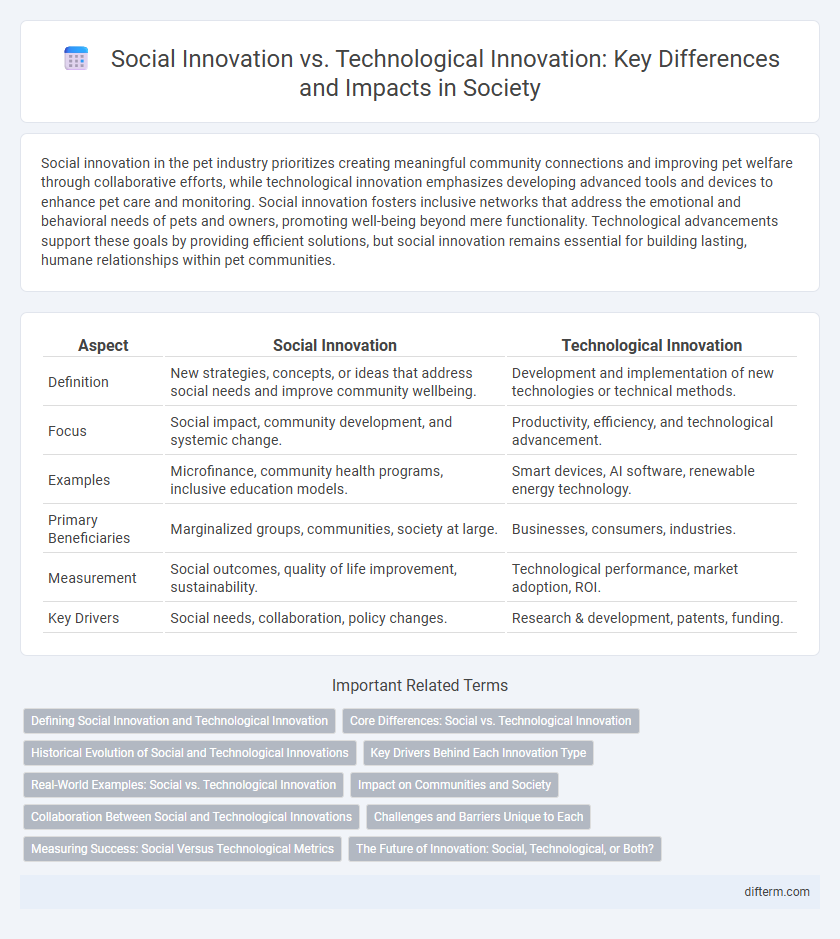Social innovation in the pet industry prioritizes creating meaningful community connections and improving pet welfare through collaborative efforts, while technological innovation emphasizes developing advanced tools and devices to enhance pet care and monitoring. Social innovation fosters inclusive networks that address the emotional and behavioral needs of pets and owners, promoting well-being beyond mere functionality. Technological advancements support these goals by providing efficient solutions, but social innovation remains essential for building lasting, humane relationships within pet communities.
Table of Comparison
| Aspect | Social Innovation | Technological Innovation |
|---|---|---|
| Definition | New strategies, concepts, or ideas that address social needs and improve community wellbeing. | Development and implementation of new technologies or technical methods. |
| Focus | Social impact, community development, and systemic change. | Productivity, efficiency, and technological advancement. |
| Examples | Microfinance, community health programs, inclusive education models. | Smart devices, AI software, renewable energy technology. |
| Primary Beneficiaries | Marginalized groups, communities, society at large. | Businesses, consumers, industries. |
| Measurement | Social outcomes, quality of life improvement, sustainability. | Technological performance, market adoption, ROI. |
| Key Drivers | Social needs, collaboration, policy changes. | Research & development, patents, funding. |
Defining Social Innovation and Technological Innovation
Social innovation refers to new strategies, concepts, or ideas that address social needs and improve community well-being, often emphasizing collaboration and inclusivity. Technological innovation involves the development and application of new technologies or scientific advancements aimed at enhancing efficiency, productivity, or functionality. Both forms of innovation drive change, but social innovation prioritizes human and societal impact, while technological innovation centers on technical progress and product development.
Core Differences: Social vs. Technological Innovation
Social innovation centers on developing novel solutions that address societal challenges, prioritizing community impact and inclusive participation, while technological innovation focuses on creating new or improved technologies that enhance efficiency and functionality. The core difference lies in their primary objectives: social innovation aims for systemic change and social value, whereas technological innovation targets technological advancement and market competitiveness. Social innovation often involves multidisciplinary collaboration and emphasizes human-centered design, contrasting with the technology-driven, product-centric approach of technological innovation.
Historical Evolution of Social and Technological Innovations
Social innovation has historically evolved through community-driven solutions addressing societal needs, exemplified by movements such as the cooperative movement in the 19th century and the establishment of microfinance in the 20th century. Technological innovation, by contrast, has rapidly progressed through industrial revolutions, from the steam engine to digital computing, driving economic and productivity growth. The intersection of social and technological innovations increasingly shapes modern solutions, integrating human-centered approaches with advanced technology to tackle complex global challenges.
Key Drivers Behind Each Innovation Type
Social innovation is driven primarily by community needs, human-centered design, and the aim to address societal challenges such as inequality, health, and education. Technological innovation is fueled by advancements in science, research and development, and competitive market forces aiming to create new products or improve efficiency. While social innovation emphasizes inclusivity and systemic change, technological innovation prioritizes scalability, performance, and commercial viability.
Real-World Examples: Social vs. Technological Innovation
Social innovation reshapes communities through grassroots solutions like microfinance in Bangladesh, which empowers low-income entrepreneurs without relying on advanced technology. Technological innovation drives progress with inventions like Tesla's electric vehicles, revolutionizing transportation by reducing carbon emissions through cutting-edge battery technology. These real-world examples demonstrate social innovation's focus on societal impact and inclusion, while technological innovation emphasizes breakthrough advancements and efficiency.
Impact on Communities and Society
Social innovation directly addresses community needs by fostering inclusive solutions that promote equity and social cohesion, often leading to sustainable improvements in quality of life. Technological innovation primarily drives efficiency and economic growth but may create disparities if access is uneven or benefits are concentrated. Combining social innovation's community-centric approach with technological advancements maximizes positive societal impact by ensuring technology serves broader social goals.
Collaboration Between Social and Technological Innovations
Collaboration between social and technological innovations drives transformative solutions by integrating human-centric approaches with cutting-edge technology, fostering inclusive and sustainable development. Social innovation enhances the relevance and adoption of technological advancements by addressing community needs, while technological innovation accelerates the scalability and impact of social programs. This synergy maximizes value creation, promotes cross-sector partnerships, and catalyzes systemic change in society.
Challenges and Barriers Unique to Each
Social innovation faces challenges such as resistance to cultural change, difficulties in measuring social impact, and limited funding from traditional investors focused on financial returns. Technological innovation encounters barriers like rapid obsolescence, high research and development costs, and regulatory hurdles that delay market adoption. Both fields require overcoming distinct obstacles related to stakeholder engagement, scalability, and resource allocation to achieve sustainable success.
Measuring Success: Social Versus Technological Metrics
Social innovation success is often measured by its impact on community well-being, social inclusion, and behavioral change, emphasizing qualitative metrics such as improved quality of life and social equity. Technological innovation typically relies on quantitative metrics like productivity gains, efficiency improvements, and market adoption rates. Evaluating social innovation requires integrating long-term societal benefits and stakeholder engagement, contrasting with the more immediate, data-driven performance indicators used in technological innovations.
The Future of Innovation: Social, Technological, or Both?
Social innovation addresses complex societal challenges by fostering inclusive solutions that prioritize human well-being and community engagement, whereas technological innovation drives advancements through cutting-edge tools and automation. The future of innovation lies in the synergy of both, integrating social values with technological breakthroughs to create sustainable and scalable impact. Embracing this integrative approach enables organizations to solve global problems more effectively, balancing ethical considerations with transformative technology.
social innovation vs technological innovation Infographic

 difterm.com
difterm.com